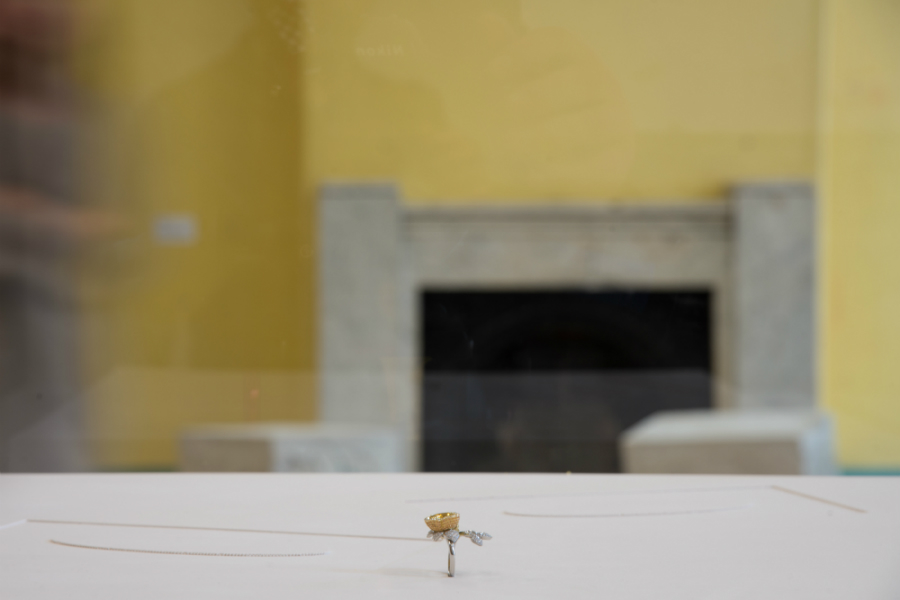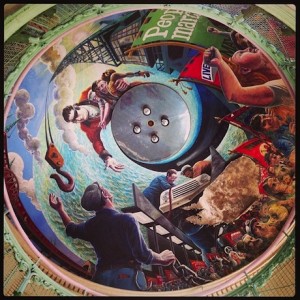Biennial 2014: Implicit Politics Are Not Enough

Laura Harris argues that Liverpool Biennial is unengaged with a political present — missing an opportunity to explore radical political alternatives and encourage dialogue between isolated communities…
It is a sad and much-discussed truth that contemporary arts institutions are suffering devastating funding cuts and staff losses right now. You need look no further than the ongoing difficulties facing National Museums Liverpool to see this political reality played out.
Even the most vital community resources — libraries, children centres (see Zoe Pilger’s article Misery on the Mersey for The Independent) — are being closed as decreasing public spending and austerity measures are seen as a ‘necessary evil’ in the face of sustaining a competitive money market.
As such, galleries and museums are increasingly being forced to justify their existence, centralising their educative, community building and pedagogical role. This informs the agenda of many national institutions; Tate Liverpool even has a Research Centre dedicated to answering questions concerning emancipatory potential (‘How can the museum develop empowered individuals, with increased historical consciousness… through engagement with art and artists?’).
Increasing historical consciousness as a method by which to empower individuals similarly informs some of the most widely seen exhibitions in the UK of the past year. From Grayson Perry’s The Vanity of Small Differences to Jeremy Deller’s All That is Solid Melts into Air, a recent trend in the contemporary national art scene has involved an engagement with cultural and community histories; the political (class) overtones are unavoidable.
By being a site for the communal exploration of a shared history, the gallery or museum can place itself at the crux of a resistance to an alienated and culturally isolated community. But, if this is the role the contemporary gallery has found for itself, what does this mean for the contemporary biennial?
The biennial format varies in its political significance. The Venice Biennale, for example, is often proposed to be outdated, relying as it does on national distinctions. However, biennials have often been sites to explore radical political alternatives. Of particular importance to this history is Documenta V (1972), which saw German artist Joseph Beuys install Informationsbüro der Organisation für direkte Demokratie durch Volksabstimmung (Information Office of the Organization for Direct Democracy Through Referendum) and proceed to engage in a 100-day-long conversation with visitors. This was an attempt to encourage inter-subjective participation; an exploration of art as it comes into ‘conflict with society and its developments.’

More recently, Mai Abu ElDahab curated Manifesta 6 (2006) for the Cypriot capital of Nicosia, which was sadly unrealised due to serious political and funding issues. This was a re-imagining of the biennial as an art school, an attempt to encourage dialogues and facilitate discussions between isolated peoples.
This year, Nicolas Bourriaud is undertaking the curation of the Taipei Biennial. Bourriaud, champion of ‘relational aesthetics’, is setting out to explore human relationships with animals, the world and one another. Each of these biennials explores and exposes the way in which an arts festival can be a site of political action, an exploration of participatory alternatives that can develop and empower.
So what happened to this year’s Liverpool Biennial? With ElDahab at the helm as co-curator, many had hoped for an overtly political curatorial gesture with echoes of Manifesta 6. Whether or not Liverpool Biennial should, in fact, be overtly political has been the overarching critical fall-out of the exhibition (see also Richard Whitby on Peter Wächtler and Jackie Wullschlager for the Financial Times). Naturally, in a city with a history riddled with social struggle and inequality such as Liverpool, it may seem that to ignore socio-political identity is an oversight.
Against a backdrop of cuts and arts job losses, the need for curatorial politics is perceivably augmented. Moreover, I believe that the choice of The Old Blind School as the main festival venue — an explicitly politicised, evocative space, set up by philanthropist Edward Rushton and more recently used as a Trade Union headquarters – is a promise of a politics that is traitorously unfulfilled. In choosing The Old Blind School, and failing to develop a social and historical narrative, an unspoken politics goes so resolutely ignored as to be offensive.
The site’s exhibition, A Needle Walks Into a Haystack, declares itself to be about our habits and habitats. Incorporated in the theme is an engagement with spaces and their significance; yet a deconstruction of the contextual history of the building is palpable in its absence. Instead of confronting this history in a socio-politically engaged manner, the show confronts us with impenetrable works coupled with impenetrable texts; we must rely on the pretentious copy of the programme as our interpreter (including highlighting that funding support has come from the Israeli Embassy; controversial given the timing, and an issue that has failed to be adequately addressed in public by the organisation. It also, of course, leads onto further ethical debate about the private funding artists and arts organisations use to survive — see Liberate Tate).
As a Biennial that concerns itself with the relationship between ‘contemporary life and art’, works such as Chris Evan’s ring (main image) serve to entrench the notion that the two are increasingly polarised. The artist — who ‘deliberately confuses the roles of artist and patron’ — has made a hideously expensive ring in collaboration with Boodles, that sits in a vitrine to be watched over by a volunteer at all times. It is a monument to money, privilege on a pedestal. At best, this work is voyeuristic; at worst, it brings to the fore the social inequalities that bubble under the surface of this building and the festival at large. For me, it reflects a curatorial approach out-of-touch with the potentialities of the biennial format.
The Old Blind School site itself is a relic of a struggle that continues; a misused packhorse carrying the weight of vacuous rhetoric under the auspices of contemporary art. Once the Biennial has closed, the building is to become a boutique hotel and a restaurant with ‘Michelin aspirations’. This is gentrification worthy of the most ardent protest, and if ‘silence becomes a type of knowledge’ in the show, as claimed, the lack of protest from within the Biennial is certainly illuminating.
Peeling from a feature dome in the roof of the building is a mural from the space’s iteration as a Trade Union centre. Workers march together, fists in the air, to a backdrop of industry: a salient reminder of the lost art of protest. As visitors are herded around the Biennial, the mural flakes further and the true significance of the building flutters with it to the floor. The Old Blind School is offering us its own metaphor; as bit-by-bit, festival programme in hand, the people’s history is ignored, as habitats go ironically unchallenged.
It is not enough to rely on implicit politics. It is not enough to suggest a history and leave it unspoken. Unengaged with a political present and an important social history, the Liverpool Biennial fails a public and a city. It is a missed opportunity to explore radical political alternatives, and encourage dialogue between people who feel largely ignored.
Laura Harris
Liverpool Biennial continues until Sunday 26 October 2014
Interested in how UK arts organisations and the Arts Council view funding cuts? See also our recent feature: What FACT’s Staff Restructure Says About Working In The Arts
Main image courtesy Mark McNulty





